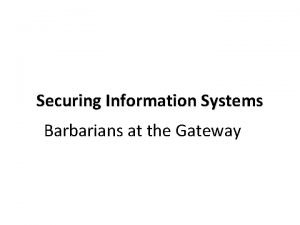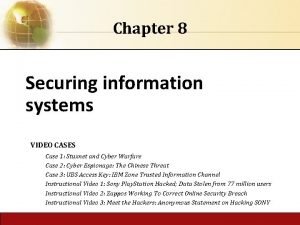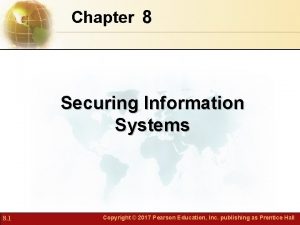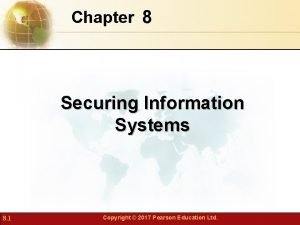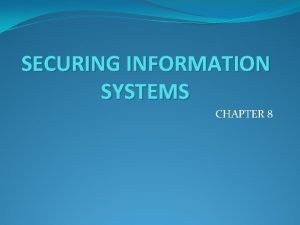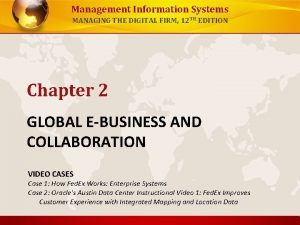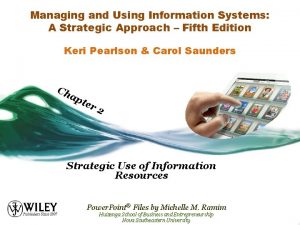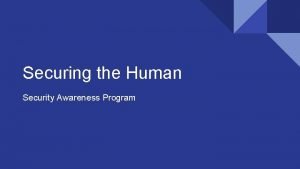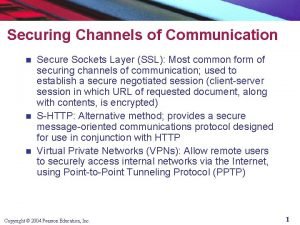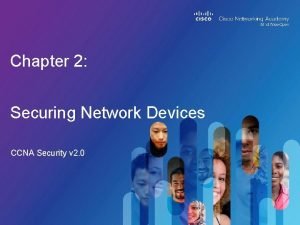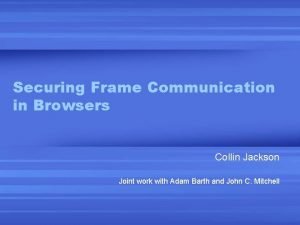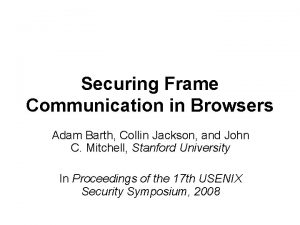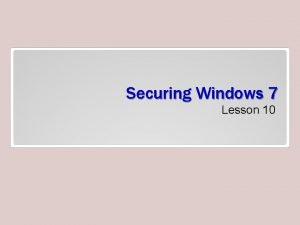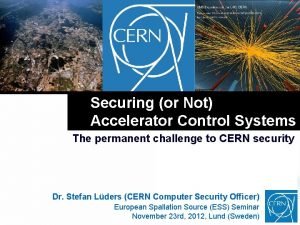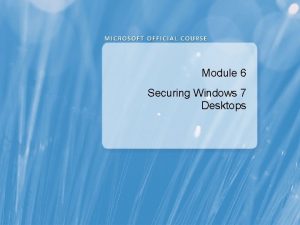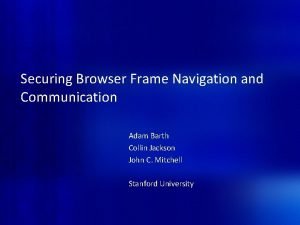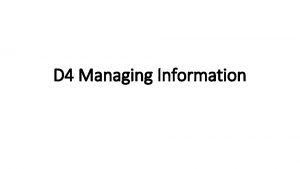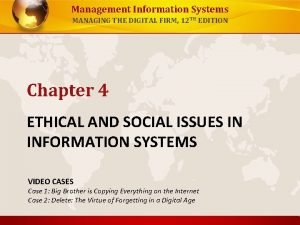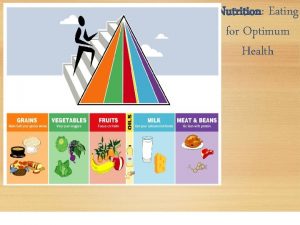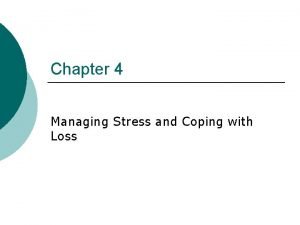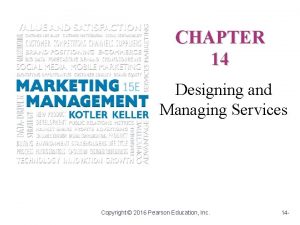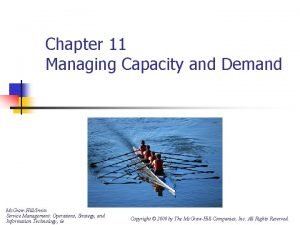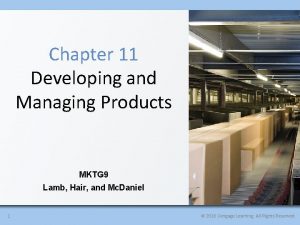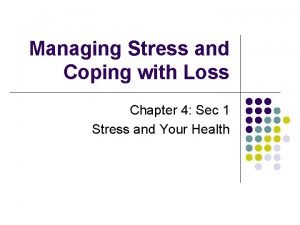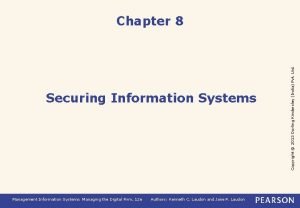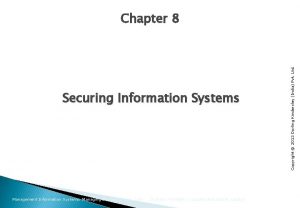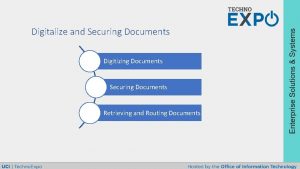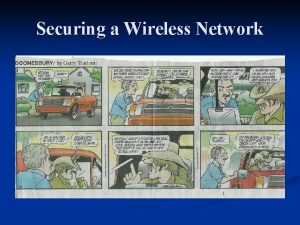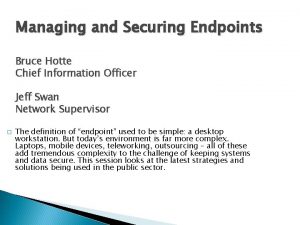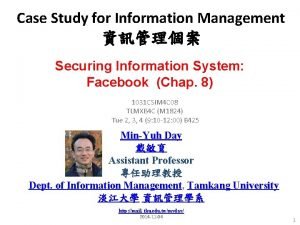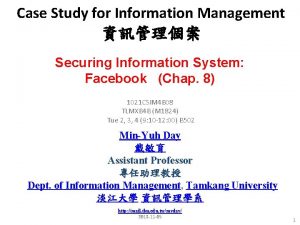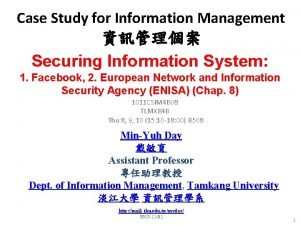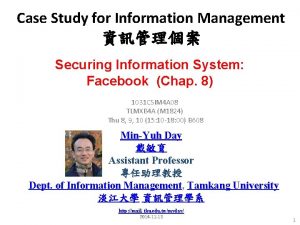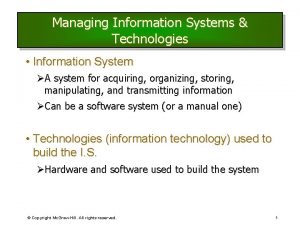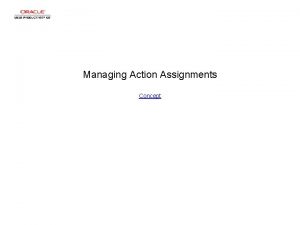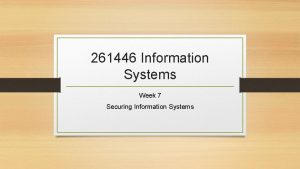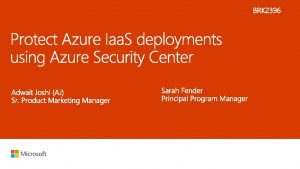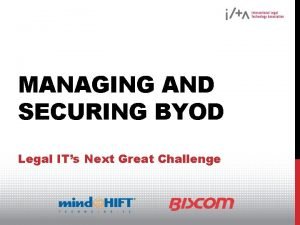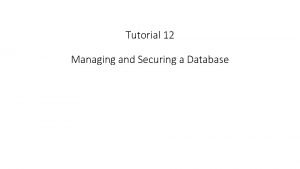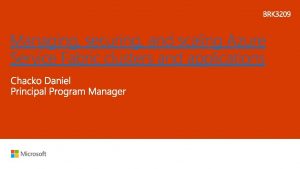Managing and Securing the Information System CHAPTER 5














































- Slides: 46

Managing and Securing the Information System CHAPTER 5

“Over 60% of the people who have a security breach, have a breach on systems that they aren't actively managing. If we would just take the time to understand where our critical information is, and then manage those systems properly, the risk reduction would be enormous. ” Dorian Cougias, Network Frontiers

Computer Dependence �How important are computers to hospitality organizations? �Turn the computer system off during a rush period and observe the consequences. �Keeping computer downtime to a minimum in guest related areas (e. g. , reservations and front desk) is critical.

Mission-Critical Systems �Mission-critical systems are systems that whose reliable performance is crucial to the successful performance of the organization in which it is used. �For a hotel, mission critical systems are central reservation system (CRS) and property management system (PMS). �For a restaurant, mission critical system is Point of Sale system (POS).

Maintaining the Systems �To make sure that these systems are up and running, there needs to be a systematic approach to maintain them. Enterprise Level Unit level (restaurant or hotel) User level (remote access- guest or staff)

All businesses are subject to business disruptions �The reasons may be different such as Fire Flood Earthquakes Vandalism Stealing Human error Utility disruptions (such as power outages) Malicious threats from outsiders or misuse of systems.

Disaster Contingency Recovery Plan �Although a DCRP is vital, it is primarily a reactive approach (i. e. , a corrective control) and not a comprehensive plan for risk management. �In contrast, a business continuity plan (BCP) seeks to eliminate or reduce the impact of a disaster condition before the condition occurs.

Business Continuity Plan �Business Continuity Planning (BCP) is an interdisciplinary concept used to create and validate a practiced logistical plan for how an organization will recover and restore partially or completely interrupted critical function(s) within a predetermined time after a disaster or extended disruption.

Common Causes of System Failure 1. 2. 3. 4. 5. 6. 7. Operator Error Hardware Failure Power Problems Software Bug System Overload Virus Spyware Apple Ad Keylogger Hardware

Operator Error �Various operator errors can cause system failure �Common errors include improper handling of lengthy processing routines (e. g. , end-of-day audit), database maintenance (e. g. , changing and deleting data), and hardware (e. g. , moving a hard disk without parking the read/write head). �Providing thorough training and establishing careful procedures reduce operator mistakes

Hardware Failure

Hardware Failure �Five basic measures reduce hardware malfunctions: 1. 2. 3. 4. 5. Keep the temperature and relative humidity at the appropriate levels Keep equipment clean Keep magnets away from computers Keep Water and corrosive agents away from computers Establish a preventative maintenance program

Fault-Tolerant �A fault-tolerant computer is equipped with a backup system enabling it to function despite the failure of certain internal hardware components such as a hard drive or disk controller card.

Storage Area Network �A storage area network (SAN) is an architecture to attach remote computer storage devices such as disk arrays to servers in such a way that, to the operating system, the devices appear as locally attached

Redundant Array of Independent Disks

Redundant Array of Independent Disks (RAID)

Internet Security Challenges

Power Problems �Power line trouble causes 70 percent of hardware and software failures. �Symptoms include burned components, garbled transactions, memory loss, corrupted data, lost data, and unexplained intermittent problems.

Power Problems �To avoid power disturbances, the following measures should be implemented. 1. 2. 3. Surge protection Proper wiring and grounding Uninterruptible Power Supply (UPS)

UPS A user level surge protection

Software Bug �A bug is a logic error in the program preventing it from working properly �For example, one hospitality accounting program aborts if the user forgets to turn on the printer before printing a financial statement

System Overload �Placing too many demands on a computer can greatly diminish its performance and may cause system failure. �Causes of system overloads include: 1. 2. 3. 4. 5. Insufficient Central Processing Unit (CPU) Clock Speed. Inadequate Random Access Memory (RAM) Slow Mechanical Components File Fragmentation Inadequate Disk Storage

External hard drive that can be connected to computer by USB or Firewire

Virus �Virus spreads by copying itself from one program to the next, changing or destroying each program that it infects without the user knowing it. �The carrier of a virus is a program that appears legitimate called a TROJAN HORSE

What to do in a Virus Attack Isolate and disconnect 2. Remove the virus 3. Restore your data 1. 2. 3. 4. Reinstall programs Scan for viruses Restore files Document the process 4. Prevent future infection 5. Learn from your mistakes

Restaurant Network Security �A computer security study was conducted among restaurant managers � 24 % of the restaurant networks had a computer network attack within the last 12 months. �On average, the restaurants received 1 -5 network attacks within the last 12 months

Attack Types �Virus Attack (71. 4%) �Insider Abuse of Net Access (57. 1%) �Laptop Theft (42. 9%) �Spoofing (39. 3%) (using someone else's resources for spam or illegal activity).


Protection from Attacks �The most used protection tool is anti-virus software (86. 2%), hardware firewall (79. 3%) and physical security (75. 9%). �The least used network security tools are honeypots (7. 7%) and biometrics (14. 8%).

Spyware �Spyware is computer software that is installed secretly on a computer to intercept or take partial control over the user's interaction with the computer, without the user's informed consent

Backup Strategies �Backup Frequency �Backup Method �Rotation of Secondary Storage Media �Hardcopy

Computer Security �Security violation examples include: Salespeople copying the hotel client list onto a USB drive and selling it to a competitor Front-desk clerks receiving cash to settle guest folios, but instead pocketing the cash and transferring the outstanding balance to a bogus city ledger account or “black hole” account. Employees gaining access to payroll records and changing wage rates. Servers voiding entree items off guest checks after collecting cash.

Security Problems �The keyboard Using obvious passwords Not regularly changing passwords Hackers �Communication Line �Internet �Physical Access

Most Common Passwords

Encryption �In the case of transmitting data over the Internet protocol, using a secure, encrypted way of communication is also a key to secure data transmission. �Computer encryption is based on the science of cryptography, which has been used throughout history. Vidoe: Encryption of Credit Card Data

Encryption



Phishing is a technique used by strangers to "fish" for information about you, information that you would not normally disclose to a stranger, such as your bank account number, PIN, and other personal identifiers such as your National Insurance number. These messages often contain company/bank logos that look legitimate and use flowery or legalistic language about improving security by confirming your identity details.

Phishing example

IT Compliance �Keeping IT systems in line with local, state, national and international level laws, regulations, standards, and policies. �The Payment Card Industry Council is a consortium of credit card issuing brands: Visa, Incorporated; American Express, Master. Card Worldwide, Discover Financial Services and JCB International

PCI DSS �PCI Council have formed this consortium to improve the security of the global payment system by protecting consumers, merchants and banks from frauds and hacks. �The consortium has created a set of Data Security Standards governing the protection of all sensitive cardholder data stored electronically or on paper. Video: PCI DSS Explained Website: PCI DSS


PCI DSS �Requirement 1: Install and maintain a firewall configuration to protect cardholder data �Requirement 2: Do not use vendor-supplied defaults for system passwords and other security parameters �Requirement 3: Protect stored cardholder data �Requirement 4: Encrypt transmission of cardholder data across open, public networks

PCI DSS �Requirement 5: Use and regularly update anti-virus software �Requirement 6: Develop and maintain secure systems and applications �Requirement 7: Restrict access to cardholder data by business need to-know �Requirement 8: Assign a unique ID to each person with computer access

PCI DSS �Requirement 9: Restrict physical access to cardholder data. �Requirement 10: Track and monitor all access to network resources and cardholder data �Requirement 11: Regularly test security systems and processes �Requirement 12: Maintain a policy that addresses information security
 Securing information systems
Securing information systems Securing information systems
Securing information systems Chapter 8 securing information systems
Chapter 8 securing information systems Securing information systems
Securing information systems Chapter 8 securing information systems
Chapter 8 securing information systems Chapter 8 securing information systems
Chapter 8 securing information systems Securing information systems summary
Securing information systems summary Chapter 8 securing the republic summary
Chapter 8 securing the republic summary Management information system managing the digital firm
Management information system managing the digital firm Managing and using information systems
Managing and using information systems Securing the human
Securing the human The most common form of securing channels is through.
The most common form of securing channels is through. Defence in depth
Defence in depth Guninski attack
Guninski attack Adam secure browser
Adam secure browser Securing windows 7
Securing windows 7 Securing
Securing Securing windows 7
Securing windows 7 The plastic cape used in draping should be
The plastic cape used in draping should be Securing the northwest territory
Securing the northwest territory Securing frame communication in browsers
Securing frame communication in browsers Managing marketing information
Managing marketing information Procedures relating to the management of information
Procedures relating to the management of information Information technology resource management
Information technology resource management Using marketing information to gain customer insights
Using marketing information to gain customer insights Management information systems managing the digital firm
Management information systems managing the digital firm Managing marketing information
Managing marketing information Chapter 8 managing stress and anxiety
Chapter 8 managing stress and anxiety Chapter 4 managing stress and coping with loss
Chapter 4 managing stress and coping with loss Chapter 6 managing weight and body composition
Chapter 6 managing weight and body composition Chapter 11 managing weight and eating behaviors
Chapter 11 managing weight and eating behaviors An extreme harmful eating behavior
An extreme harmful eating behavior Chapter 1 management
Chapter 1 management Managing weight and eating behaviors
Managing weight and eating behaviors Chapter 6 managing weight and body composition
Chapter 6 managing weight and body composition Types of jaycustomers
Types of jaycustomers Chapter 11 managing weight and eating behaviors answer key
Chapter 11 managing weight and eating behaviors answer key Chapter 4 managing stress and coping with loss
Chapter 4 managing stress and coping with loss Designing and managing services kotler keller ppt
Designing and managing services kotler keller ppt Chase demand strategy
Chase demand strategy Developing and managing products
Developing and managing products Chapter 4 lesson 2 managing stress answer key
Chapter 4 lesson 2 managing stress answer key Chapter 13 managing change and innovation
Chapter 13 managing change and innovation Chapter 11 managing weight and eating behaviors
Chapter 11 managing weight and eating behaviors Chapter 4 managing stress and coping with loss
Chapter 4 managing stress and coping with loss Chapter 7 managing risk vision and perception
Chapter 7 managing risk vision and perception Chapter 6 managing weight and body composition
Chapter 6 managing weight and body composition
